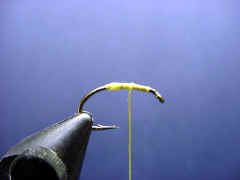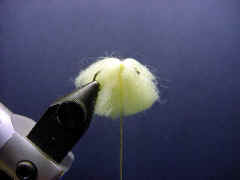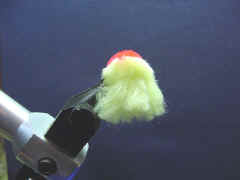|
Fly of the Month Bob Ireton brings together his experience in fly fishing, aquatic entomology, and knowledge of fly tying techniques and materials, to design and tie durable and effective flies. |

|
![]()
Volume 3, Issue 10
October 2002
![]()
SALMON EGG
Fly and Text by Bob Ireton
Photography by Bob Kimsey and Bob Ireton
Once Salmonid anglers learned of the ravenous fish egg eating abilities of migrating steelhead and salmon, both West Coast and Great Lakes steelheaders have had a long affair with colored yarn.
With the egg flies meager beginnings from the corner yarn shop to the patterned ‘Glo Bug’ egg fly pioneered by Anderson, California’s Bug Shop operation, the egg fly is perhaps the single most important and often used pattern in the Great Lakes. The perfectly round ‘Glo Bug’ with colored dot to show the nucleus or eye-up version of the egg, is still the most seductive and widely used pattern.
By using different materials and hook sizes, there is almost an endless array of egg patterns to be tied. Although best known as a steelhead fly, the egg pattern works well for other species. I have personally used it to catch trout, bass, carp, catfish, etc. If you had a fly box of only different colors and sizes of egg flies, I believe you could catch practically any fish!
MATERIALS
Hook – TMC 2457, TMC 105, Mustad 80200BR, Dai-Riki 135, Daiichi 1150, Daiichi 2571
Size 6,8,10
Thread – 3/0 or equivalent. Color to match the egg yarn
Body – Egg Yarn: chartreuse, fl. orange, oregon cheese, peach, pink, red
TYING STEPS
Copyright © 1998 - thisyear The Buckeye United Fly Fishers, Inc. Cincinnati, OH 45242
The Buckeye United Fly Fishers, Inc is a non-profit corporation organized under section 501(c)(3) of the Internal Revenue Code, incorporated in the State of Ohio for the preservation, conservation and wise use of our fishing waters and game fish; and to assist in the protection and improvement of our natural resources




